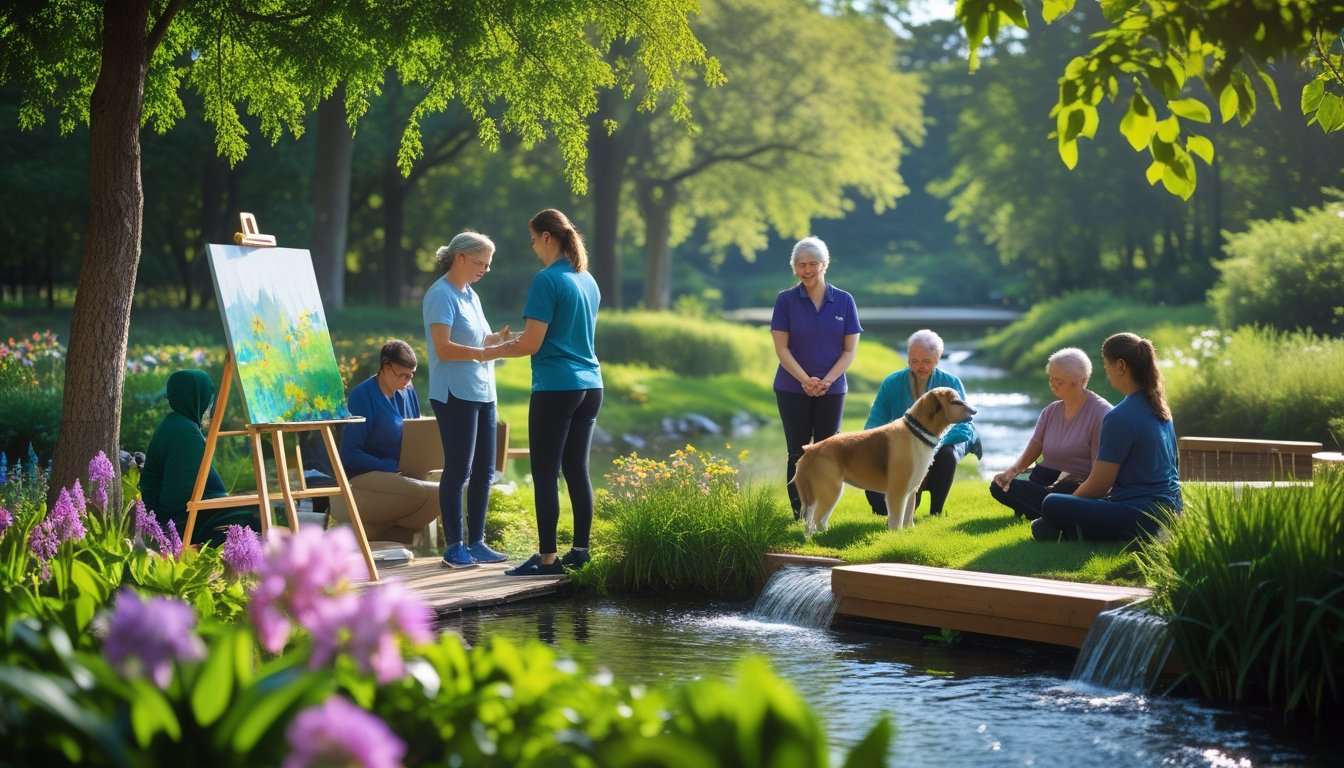Late updated: 10 Oct 2025 11:10
Written by: Ella Thompson
Exploring Innovations In Environmental Therapy Techniques: Advances And Applications
In today's rapidly evolving world, innovative approaches in therapy are gaining attention for their potential benefits. Environmental therapy, often known as ecotherapy, offers a unique way to enhance both physical and mental well-being. By employing techniques that integrate the healing effects of nature, this therapeutic approach encourages individuals to reconnect with the environment, fostering improved health outcomes.

The therapeutic journey through nature can be both invigorating and soothing, providing an alternative to traditional therapy methods. Techniques like ecotherapy and environmental therapy extend beyond personal health, suggesting a synergistic relationship between individual well-being and ecosystem health. This perspective aligns with the idea that taking care of our natural surroundings can, in turn, nurture our own minds and bodies.
By exploring these techniques, we can uncover the various pathways through which nature fosters healing. From practical applications in stress reduction to the incorporation of animal interactions, the possibilities offered by environmental therapy are vast and promising.
Key Takeaways
- Ecotherapy enhances mental and physical health via nature.
- Innovative techniques bridge personal and environmental well-being.
- Diverse methods, including animal-assisted therapy, create new possibilities.
Core Innovations in Environmental Therapy Techniques
Innovations in environmental therapy are transforming the landscape of mental well-being. Techniques such as mindfulness in natural settings and forest bathing leverage the natural environment to boost mental wellness effectively. These methods are designed to foster a deeper connection between individuals and nature, utilising practices like mindful hiking, and gardening to support emotional healing and psychological health.
Mindfulness Practices in Nature
Mindfulness in nature combines traditional mindfulness with the calming influence of the natural world. This practice involves being fully present in outdoor settings, which helps reduce stress and anxiety. Engaging all senses in nature allows us to experience a sense of tranquillity.
Nature has a unique way of fostering mindfulness by enhancing our focus on the present moment. The sounds, scents, and sights of the environment encourage a profound awareness. Through guided practices, individuals can attune themselves to their surroundings, helping to release negative emotions and improve overall well-being.
Forest Bathing and Its Psychological Benefits
Forest bathing, or Shinrin-yoku, originated in Japan and involves immersing oneself in a forest environment. This practice is recognised for its capacity to lower cortisol levels and reduce stress. By simply being among the trees, we can experience a noteworthy shift in mood and cognitive clarity.
Studies suggest that the practice enhances the release of endorphins, promoting a sense of calm and joy. The natural atmosphere augments mind-body harmony, facilitating rejuvenation and mental clarity. Spending time in forests can significantly boost immune function, simply by embracing the forest’s tranquil energies.
Mindful Hiking and Emotional Healing
Mindful hiking combines physical activity with mindfulness, focusing on the rhythm of walking through nature. This method offers an opportunity for introspection, aiding emotional well-being. As our pace aligns with nature, stress levels decrease and mental clutter diminishes.
The synergy of hiking and mindfulness enables deeper emotional healing. With each step, we connect with our inner selves and nature, creating mental space to process emotions. Hiking mindfully aids in the release of endorphins, enhancing mood and fostering resilience against anxiety and depression.
Gardening Therapy Approaches
Gardening therapy allows individuals to engage with nature directly, enhancing mental health through hands-on interaction with plants. This approach is effective in reducing symptoms of depression and anxiety. The process of planting, nurturing, and observing growth cultivates patience and mindfulness.
Gardening offers a unique therapeutic experience by combining physical activity with the calming effects of nature. Harvesting one’s own produce or merely tending to plants induces a sense of accomplishment and purpose. Colourful blooms and leafy greens can stimulate the senses, promoting overall mental wellness.
Creative and Animal-Assisted Approaches in Environmental Therapy

In exploring innovations in environmental therapy, we find that integrating creative arts and animal-assisted therapy offers promising benefits. These approaches not only foster mental health but also boost endorphins, enhancing overall emotional resilience.
Art Therapy and Nature Integration
Art therapy in conjunction with nature involves using the environment as both a backdrop and inspiration for creative work. We often see participants engaging in activities such as painting or sculpting using natural materials. By harnessing the therapeutic potential of the outdoors, we help individuals connect with their emotions in a soothing setting. These sessions can be tailored to individual needs, incorporating elements of mindfulness and meditation for greater psychological balance. The emphasis on natural elements also promotes eco-awareness, encouraging individuals to value and protect their environment.
Animal-Assisted Therapy for Enhanced Engagement
Animal-Assisted Therapy (AAT) brings trained animals into treatment settings to stimulate engagement and healing. Animals such as dogs, horses, and even dolphins are used to lower stress and promote social interaction. We utilise the innate bond between humans and animals to establish trust and emotional comfort. AAT has shown effectiveness in diverse scenarios, including improving mental health and supporting recovery from trauma. In addition, this approach is adaptable, allowing us to design sessions that fit different therapeutic goals. Whether in hospitals or outdoor environments, the presence of animals fosters a calming effect and encourages openness among participants.
Endorphin-Boosting Environmental Activities
Engaging in environmental activities can significantly raise endorphin levels, enhancing mood and well-being. Activities like wilderness walks, gardening, and playing with animals naturally increase endorphin production. We often integrate these activities into therapy sessions to combat depression and anxiety. The physical movement involved offers both mental and physical benefits, making it a holistic approach to therapy. Regular engagement in such activities also encourages a sustainable lifestyle, reinforcing the importance of maintaining a healthy relationship with nature. By focusing on these endorphin-boosting practices, we support overall health improvement for individuals in therapy.
Frequently Asked Questions

In recent years, environmental therapy techniques have gained prominence as viable mental health interventions. These methods harness natural settings to promote psychological well-being, often complementing traditional practices.
What are the latest advancements in nature-based therapy?
Recent innovations in nature-based therapy include forest bathing, animal-assisted therapy, and therapeutic farming. These approaches utilise direct interaction with nature to facilitate healing, encouraging mindfulness and reconnection with the environment.
How can environmental therapy be integrated into conventional mental health treatment plans?
Integrating environmental therapy into traditional treatment plans involves combining activities like guided nature walks and horticultural therapy with standard therapeutic practices. This holistic approach can provide a more comprehensive model of care by addressing both physical and mental health symptoms through the healing power of nature.
What evidence supports the efficacy of ecotherapy in reducing symptoms of stress and anxiety?
Several studies have highlighted ecotherapy's potential in decreasing stress and anxiety. Research indicates that regular exposure to natural environments can lower stress hormone levels, increase serotonin, and enhance mood stability by providing sensory stimulation distinct from urban settings.
Which environmental therapy techniques show promise for improving cognitive function?
Techniques such as nature walks and forest bathing are believed to enhance cognitive function. Engaging with the natural world can improve attention, memory, and critical thinking. Access to green spaces is beneficial for both children and adults, aiding in the cognitive development and maintenance.
Can environmental therapy contribute to overcoming technology-related lifestyle issues?
Environmental therapy offers potential solutions to technology-related issues by encouraging disconnection from digital devices. Activities like mindful hiking and creative nature journaling prompt individuals to engage physically and mentally with their surroundings, helping mitigate screen fatigue and promoting a balanced lifestyle.
What role does urban green space play in environmental therapy?
Urban green spaces are crucial for offering accessible nature interaction within cities. They provide settings for therapeutic activities, support biodiversity, and act as stress-reducing environments. By fostering community engagement, these spaces can improve public mental health and increase environmental awareness among urban residents.
